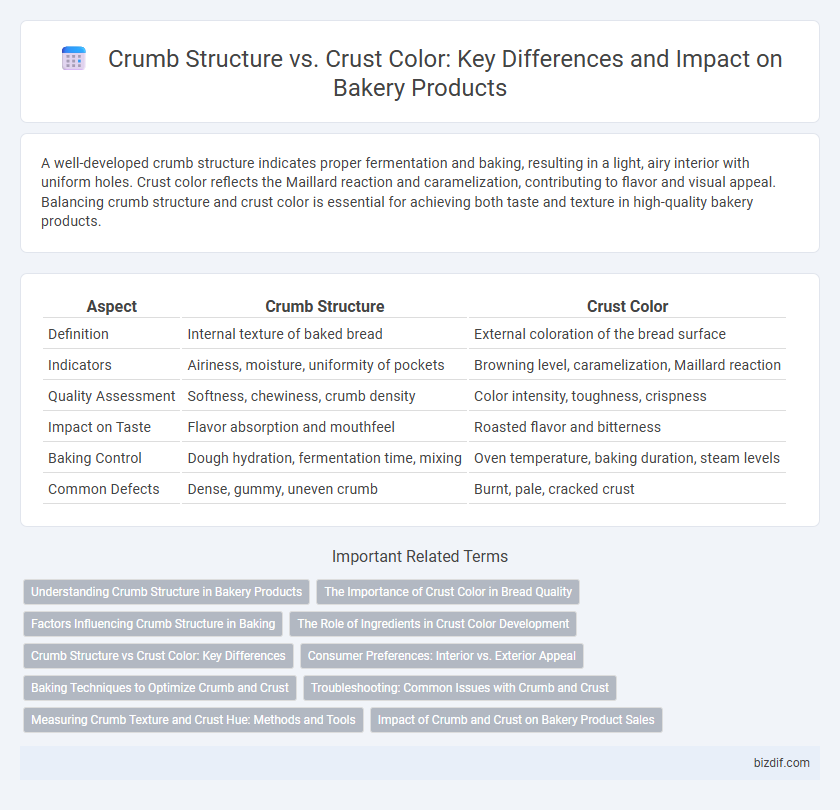A well-developed crumb structure indicates proper fermentation and baking, resulting in a light, airy interior with uniform holes. Crust color reflects the Maillard reaction and caramelization, contributing to flavor and visual appeal. Balancing crumb structure and crust color is essential for achieving both taste and texture in high-quality bakery products.
Table of Comparison
| Aspect | Crumb Structure | Crust Color |
|---|---|---|
| Definition | Internal texture of baked bread | External coloration of the bread surface |
| Indicators | Airiness, moisture, uniformity of pockets | Browning level, caramelization, Maillard reaction |
| Quality Assessment | Softness, chewiness, crumb density | Color intensity, toughness, crispness |
| Impact on Taste | Flavor absorption and mouthfeel | Roasted flavor and bitterness |
| Baking Control | Dough hydration, fermentation time, mixing | Oven temperature, baking duration, steam levels |
| Common Defects | Dense, gummy, uneven crumb | Burnt, pale, cracked crust |
Understanding Crumb Structure in Bakery Products
Understanding crumb structure in bakery products reveals essential insights into texture, moisture retention, and overall quality, with key factors including the distribution of air pockets and gluten development. Crust color, influenced by Maillard reactions and caramelization during baking, provides visual cues but does not solely dictate the crumb's internal characteristics. Analyzing crumb structure alongside crust color enables bakers to optimize baking times and temperatures to achieve desired product consistency and appeal.
The Importance of Crust Color in Bread Quality
Crust color plays a crucial role in bread quality, influencing both the visual appeal and perceived freshness of the loaf. A well-developed Maillard reaction results in a rich, golden-brown crust that signals optimal baking and enhances flavor complexity. While crumb structure affects texture, the crust color often serves as the primary indicator of proper baking and overall bread quality to consumers.
Factors Influencing Crumb Structure in Baking
Crumb structure in baking is primarily influenced by factors such as flour type, hydration levels, mixing method, and fermentation time, which determine the texture and airiness of the bread. Enzymes and yeast activity impact gas retention, creating the open or tight crumb, while temperature control during baking affects crumb set and moisture distribution. Crust color results from Maillard reaction intensity and baking duration, which varies independently from crumb characteristics though both are essential for overall bread quality.
The Role of Ingredients in Crust Color Development
The role of ingredients such as sugar, milk, and fats significantly influences crust color development in baked goods through Maillard reactions and caramelization. Higher sugar content enhances browning by providing more reducing sugars, while milk contributes lactose that intensifies crust color. Fat content also affects heat transfer, promoting even crust formation and depth of color in bread and pastries.
Crumb Structure vs Crust Color: Key Differences
Crumb structure refers to the internal texture of baked goods, characterized by cell size, moisture content, and density, while crust color indicates the external browning resulting from Maillard reactions and caramelization. The crumb structure impacts softness and chewiness, whereas crust color affects visual appeal and flavor complexity. Key differences lie in their formation processes and their influence on overall sensory experience, with the crumb reflecting fermentation and baking time and the crust signaling heat exposure and sugar content.
Consumer Preferences: Interior vs. Exterior Appeal
Consumer preferences in bakery products often balance crumb structure and crust color, with some favoring a soft, airy interior that indicates freshness and quality, while others prioritize a golden, crisp crust signaling careful baking and flavor depth. The interior appeal of a well-developed crumb can enhance mouthfeel and perceived moisture, whereas the exterior crust color influences visual attractiveness and expectations of texture. Bakers aiming for optimal consumer satisfaction focus on achieving a harmonious contrast between the delicate crumb and vibrant, appealing crust to meet diverse taste and aesthetic preferences.
Baking Techniques to Optimize Crumb and Crust
Baking techniques such as precise temperature control and steam introduction during baking significantly impact crumb structure and crust color. Higher oven temperatures develop a darker, caramelized crust while shorter bake times preserve a moist, open crumb. Adjusting dough hydration and fermentation also refines crumb texture, balancing softness with crust crispness for optimal bakery quality.
Troubleshooting: Common Issues with Crumb and Crust
Uneven crumb structure often results from insufficient kneading or improper fermentation, causing dense or gummy interiors in baked bread. Thick, dark crusts may indicate overbaking or too high oven temperatures, while pale crusts often point to underbaking or low heat. Adjusting baking time, temperature, and fermentation processes can help balance crumb texture with crust color for optimal bakery product quality.
Measuring Crumb Texture and Crust Hue: Methods and Tools
Measuring crumb texture involves using texture analyzers that assess parameters such as firmness, springiness, and cohesiveness to quantify the internal structure of baked goods. Crust hue is evaluated through colorimeters or spectrophotometers, providing objective data on browning intensity and uniformity based on CIE L*a*b* color space values. Combining these methods ensures precise control over product quality, balancing crumb softness with desired crust coloration for optimal sensory appeal.
Impact of Crumb and Crust on Bakery Product Sales
Crumb structure and crust color significantly influence bakery product sales by affecting consumer perception and taste expectations. A tender, airy crumb paired with a rich, golden-brown crust enhances visual appeal and mouthfeel, driving repeat purchases. Consistent crumb and crust quality correlate with higher customer satisfaction and stronger brand loyalty in competitive bakery markets.
Crumb structure vs Crust color Infographic

 bizdif.com
bizdif.com